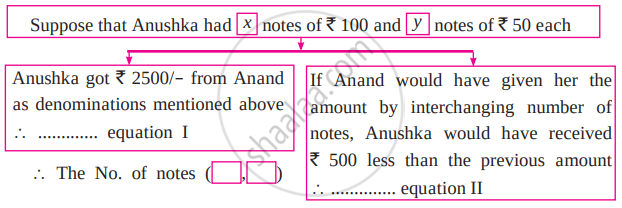Advertisements
Advertisements
Question
If the cost of bananas is increased by Rs. 10 per dozen, one can get 3 dozen less for Rs.600. Find the original cost of one dozen of bananas.
Solution
Let x be the original cost of a dozen bananas.
For Rs. 600 let us one gets y dozens.
`xy =600` .................... (1)
`y=600/x`
By increasing the cost of 1 dozen of bananas by Rs. 10 we get 3 dozen less bananas
`(x +10)(y - 3)=600 ` ............................(2)
Substituting the y value in (2), we get
`(x+10)(600/x-3)=600`
`(x+10)((600-3x)/x)=600`
`(10+x)(600-3x)=600x`
`6000+570x-3x^2=600x`
`6000-30x-3x^2=0`
`3(x^2+10x-2000)=0`
`x^2+10x-2000=0`
`(x+50)(x-40)=0`
`x=-50 or 40`
Since cost of bananas cannot be negative, x = 40.
So, the original cost of one dozen of bananas is Rs.40
APPEARS IN
RELATED QUESTIONS
On the first day of the sale of tickets of a drama, in all 35 tickets were sold. If the rates tickets were Rs. 20 and Rs. 40 per ticket and the total collection was Rs, 900, find the number of tickets sold of each rate.
Two numbers differ by 3. The sum of twice the smaller number and thrice the greater number is 19. Find the numbers.
Complete the following.

The sum of father’s age and twice the age of his son is 70. If we double the age of the father and add it to the age of his son the sum is 95. Find their present ages.
Solve the following word problem.
A two-digit number and the number with digits interchanged add up to 143. In the given number the digit in unit’s place is 3 more than the digit in the ten’s place. Find the original number.
Let the digit in unit’s place is x
and that in the ten’s place is y
∴ the number = `square` y + x
The number obtained by interchanging the digits is `square` x + y
According to the first condition two digit number + the number obtained by interchanging the digits = 143
∴ 10y + x + `square` = 143
∴ `square` x + `square` y = 143
x + y = `square` ........(I)
From the second condition,
digit in unit’s place = digit in the ten’s place + 3
∴ x = `square` + 3
∴ x − y = 3 ........(II)
Adding equations (I) and (II)
2x = `square`
x = 8
Putting this value of x in equation (I)
x + y = 13
8 + `square` = 13
∴ y = `square`
The original number is 10 y + x
= `square` + 8
= 58
Kantabai bought \[1\frac{1}{2}\] kg tea and 5 kg sugar from a shop. She paid ₹ 50 as return fare for rickshaw. Total expense was ₹ 700. Then she realised that by ordering online the goods can be bought with free home delivery at the same price. So next month she placed the order online for 2 kg tea and 7 kg sugar. She paid ₹ 880 for that. Find the rate of sugar and tea per kg.
Solve the following word problem.
To find number of notes that Anushka had, complete the following activity.

Solve the Following Word Problem.
Sum of the present ages of Manish and Savita is 31. Manish’s age 3 years ago was 4 times the age of Savita. Find their present ages.
Solve the Following Word Problem.
Places A and B are 30 km apart and they are on a st raight road. Hamid travels from A to B on bike. At the same time Joseph starts from B on bike, travels towards A. They meet each other after 20 minutes. If Joseph would have started from B at the same time but in the opposite direction (instead of towards A) Hamid would have caught him after 3 hours. Find the speed of Hamid and Joseph.
The sum of a two digit number and the number obtained by reversing its digits is 121. Find the number if its units place digit is greater than the tens place digit by 7.
Out of 555 km, Vishal travelled certain distance by bus and
remaining distance by car. A bus travels with an average speed of 60 km/hr and the average speed of a car is 75 km/hr. He takes total 8 hours to complete the journey. Find the distance that Vishal travelled by bus.
I held a number 75 in my mind. Write any condition showing the relation between their digits. Write the condition showing the relation between the number and the number obtained by interchanging the digits
From the railway station I took a rickshaw to go home. It is decided that I have to pay ₹ X for the first kilometre and for each kilometre ₹ Y for the next. For 10 kilometres the fare is ₹ 40 and for 16 kilometres fare is ₹ 58. Find the fare for the first kilometre
Roshan spends 80% of the money that he receives every month and saves ₹ 2500. How much money does he get monthly?
Let the total money be x.
Then, Amount spend = `square/100`
Amount saved = ₹ `square`
Now, `square/100 + square` = x
`x - square/100 = square`
`square/100 = square`
x = `(square xx 100)/square`
x = `square`
Hence, Roshan get ₹ `square` as monthly Salary.
